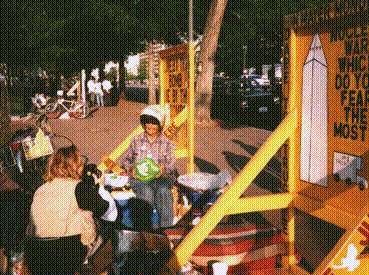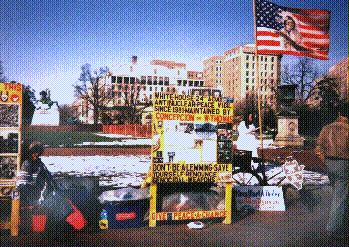Thursday, December 22, 1994
Washington Post - Two Worlds Collide Near White House
By DeNeen L. Brown and Wendy Melillo
Sunday, June 19, 1994
14 JAHRE FUR DEN FRIEDEN
 TAG UND NACHT VORM WEIBEN HOUS;
TAG UND NACHT VORM WEIBEN HOUS;14 JAHRE FUR DEN FRIEDEN
 Von unserem Korrespondenten Peter W, Sschroeder
Von unserem Korrespondenten Peter W, SschroederBREMER
Sonntag, 19, Juni 1994
NACHRICHTEN
Washington, Amerikaniche Peasidenten Kommen und gehen,, aber sie bleibt; Concepcion Picciotto Vor l4 Jahren zog die geburtige Spanieren mit Friedensplakaten vor das WeiBe Haus und und blieb. Sie hat ihren Plaatz seit uber 5000 Tagen und Nachten nicht mehrr verlassen, Wenn die da ver nunftig werden" sagt die 49jahrige Frau und zeigt auf den gegenuberliegenden Amtssitz des Prasidenten, dann kann ich in die Gesellscraft zuruckkehren :Abersieist beinahe sicher, auf dem Pflaster vor dem WeiBen Hous zu sterben.
Etlichen Amerikanern war und ist Concepcion ein Dorn im Auge,, Fur die ehemalige First Lady Nancy Reagan war die Dauerdemostrantin mit ihren beleiddigenden Transparenten: ein :Schandfleck: Der damalige Innenminister betrachtete die Friedenskampferin als Sicherheitsriisiko und verbot jegliche Demostration auf demm Gehweg vor der Schlaf und Arbeitsstatte des Prasidenten Daraufhin siedelte Concepcion zur enderen StraBenseite uber, an den Rand des Lafayette-Parks. Dort wird sie haufig von patriotischen Amerikanern angepobelt.
Wahrend des Golfkrieges wurde sie von einem Marines zusammengeschlgen, Ein in der Nahe stehender Polizist drehte sich um sah weg. Auch die Administration bemuht sich seit Jahren mit UNO-Angestellte Concepcion zu vertreiben, Beispielsweise dart sich niemand in der Nahe des WeiBen Houses Schlafen legen, Wenn ein Demosntrant sich weiter als einen Meter von seinen Besitztumern- ein-schlieBlich der Protesttschilder- entfernt…..
, durten sie von den sprungbereiten Polizisten beschlagnahmt werden.
Mit dem Einzug von Bill Clinton sind die Belastigungen seltener geworden" sagt die Dauerdemonstrantin, Hillary Clinton-Fan ist Concepcion deshalb noch lange nicht geworden. Der ist elwas besser als die anderen, aber fur den Frieden tut er nich genug Auch unter Clinton gilt weiterhin das Schlafverbot vor dem WeiBen Haus, Inzwischen hat sich Concepcion das Schlafwn abgwohnt. Irgendwann in der Nacht hockt sie sich aufeinen kleinen Karton und dost vor sich hin. Mehr als drei Stunden Ruhe Kommen aberr nur in wenigen Nachten Zusammen.
Im Winter, wenn die Quecksilbersaule oft auf mehi als 20 Grad minus fallt, macht sie die Augen immer nur fur ein paar Minuten zu= aus Angst vor dem Erfrieren. Ansonsten furchtet sie nur noch vor dem, Erfrieren, Ansonsten furchtet sie sich nur noch vor dem Alter,
Passanten drucken ihr gelegentlich Dollarscheine in die Hand, DDaavon laBt sie Handzettel mit Friedensbotschften drucken und kaufl blaue und weiBe Farbe, mit der sie Friedenstauben auf Steine malt. Die Stteine verschenkt sie als Mahnung, daB wir Frieden brauchen" Sie sollen auch ihr Vermachtnis sein,, Die Friedenstauben wird es noch geben, wenn ich nicht mehr demonstrieren kann.
Wednesday, June 1, 1994
Protesten als dagtaak

Protesten als dagtaak
jan doets america tours
amerika & canada
revue 1994

P.S. van Jan Doets: "Wanneer u een bezoek brengt aan Washington D.C., gaat u dan ook eens langs bij mevrouw Picciotto."
Wednesday, April 13, 1994
The Washington Post Friday, May 13, 1994
The Washington Post
Friday, May 13, 1994
Friday, May 13, 1994
History in The Square
By Linda Wheeler
Washington Post Staff Writer

Subscribe to:
Posts (Atom)